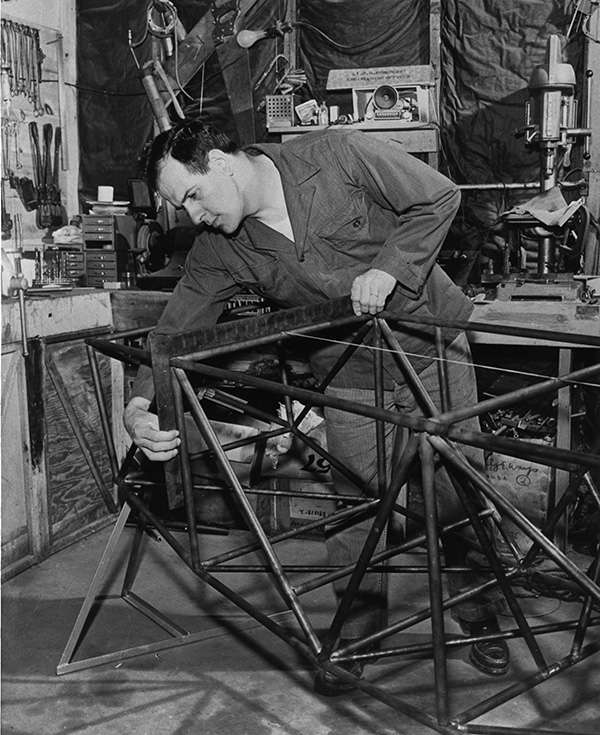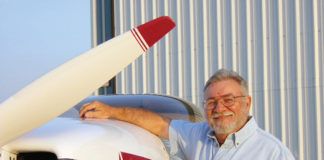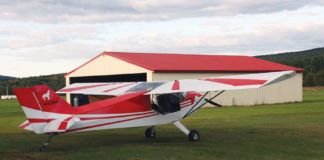It’s been nearly a year since grassroots aviation lost Paul H. Poberezny, one of its founders, a pillar of the entire homebuilt industry. Time brings perspective and heals broken hearts, but that doesn’t mean that Paul isn’t missed. He most decidedly is.
“Paul Howard Poberezny was aviation’s ultimate teacher, an insatiably curious student of all aspects of flight and its practitioners,” said Scott Spangler, editor of Jetwhine.com, Droneport.com, freelance writer, and former editor of Sport Aviation and Flight Training magazines. “The only things that surpassed his joy of learning something or meeting someone new was sharing what he’d learned or who he’d met with others. He was, perhaps, the last pioneer of aviation’s golden era,” Spangler continued, smiling wistfully as he remembered the relationship he shared with Paul, which spanned decades.
He met Paul at the first EAA fly-in he attended, back in 1978 at Halles Corners. Just released from the Navy and dreamy-eyed about all things airborne, Spangler knew little about homebuilding, except that it was probably the only way he’d ever be able to afford an airplane of his own. Well, an airplane big enough to carry his rather impressive sized frame (he can look well-over the top of most crowds, and required a C172 for his flight training to make weight and balance work out). In 1978 the Acrosport had just come out, and Spangler wandered over to the EAA museum to ask about it.
They said, “Let’s get Paul,” he remembered. “I knew he was the president of EAA, and busy. But we sat and talked and rolled out a set of plans. He was 100% there, taking more than an hour out of his time during the fly-in to talk about how we might modify [the aircraft] for me.” Paul sent Spangler down to Burlington Flight Center to climb into the prototype, and he bought a set of plans for the aircraft and joined EAA on the spot. “I’ve been to every EAA convention and fly-in since!” laughed Spangler.
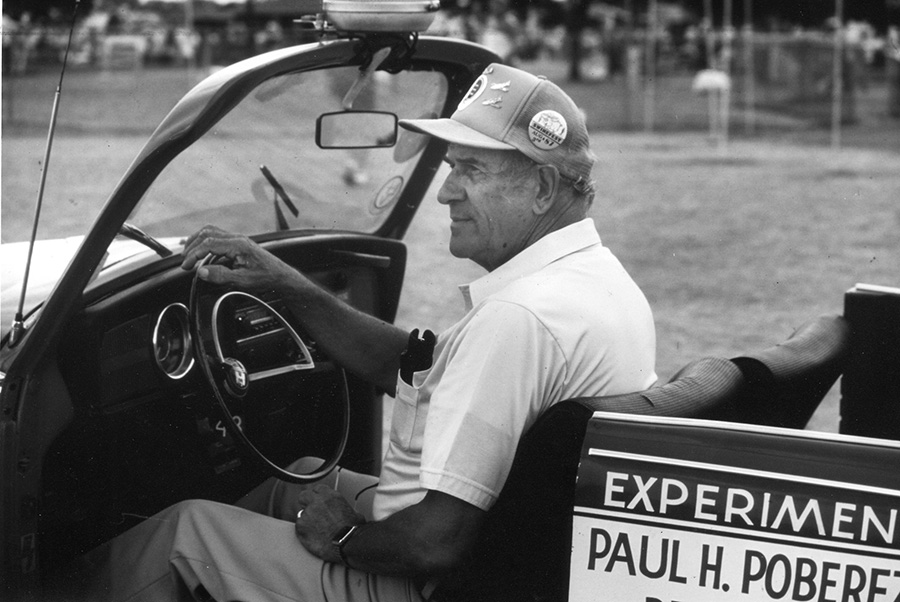
Paul and Red One. The highly modified Volkswagen is certainly one of the most recognizable Experimental vehicles to appear at Oshkosh.
More than a decade and a half later, Spangler found himself working at EAA headquarters, and it wasn’t long before he discovered that Paul’s office was the place to go when researching historical stories. “I’d schedule meetings with him for research and clear the decks because I knew we’d go off on tangents and talk and talk. He knew everyone and was involved in so much history…and like my dad’s generation, he saved everything.”
That was Paul. From the day he discovered winged flight he was “in.” It’s a good thing he met and married Audrey when he did, because without her willingness to go “all-in” with him, Experimental aviation as we know it today might not exist.
Talk About Teamwork
Lucky for us in the early 1990s, Paul and Audrey’s daughter Bonnie, who, like her brother Tom, was wrapped up in the family business from an early age, took the time to interview her parents extensively about the formation of EAA, and with her husband, Chuck Parnall, compiled it all into a book, Poberezny, The Story Begins…The interviews reveal that during the critical formation of EAA, it was Audrey’s tireless devotion to the paperwork, including correspondence and the myriad of skills required to type up, layout and produce The Experimenter, EAA’s first publication, that kept the organization both running and growing. There’s a reason that the Poberezny’s basement is an exhibit in the EAA museum in Oshkosh, Wisconsin. That’s where it all started.
Paul was gone from home a lot, first in the military, the reserves, and then lobbying the CAA (predecessor of the FAA), a lot of the time. That left Audrey taking care of two small children, the house and property, and the fledgling non-profit. No one debates this: they were a team.
Lucky for Paul and Audrey, their son and daughter were capable, competent, and willing to be a part of what their parents created. Lucky for them, so were a whole lot of other people who have become key players in homebuilt aviation today.
Around the Airport: the Preacher
“He called a lot of people ‘son,'” laughed John Monnett, founder and president of Sonex Aircraft, based in Oshkosh, Wisconsin. Monnett’s relationship with Paul went back to around 1966 or so. “Tom and I looked a lot alike in those days…even Tom’s wife Sharon mistook me for him once from behind.”
With his kit aircraft manufacturing company right around the corner from EAA headquarters, Paul was a frequent visitor, and yes, he did offer advice. According to Monnett, some of it was even taken.
“That museum was spic and span, and I knew when Paul was coming over, my shop better be that way, too,” chuckled Monnett. Fortunately his years as a schoolteacher made that kind of discipline second nature. “Sure, he had his idiosyncrasies…but he wanted so much to share his passion. I think what Paul liked about the kind of stuff we were doing at Sonex was the way we were pushing the envelope. I remember him shaking his head and saying, ‘How cool.'”
In later years, when Paul was no longer president of EAA, but still guiding it, he’d ask Monnett where he thought “things were going” with EAA, and they’d talk about it. Said Monnett, “He cared. He was sensitive to criticism, like anyone, but he cared so much for the organization that he didn’t want to rock it too much. I remember once, right before I was supposed to speak at an EAA meeting, he gave me the “keep it down” signal, right from the audience, asking me, essentially, to tone down my rhetoric—and it was good advice. That night, I took it.”
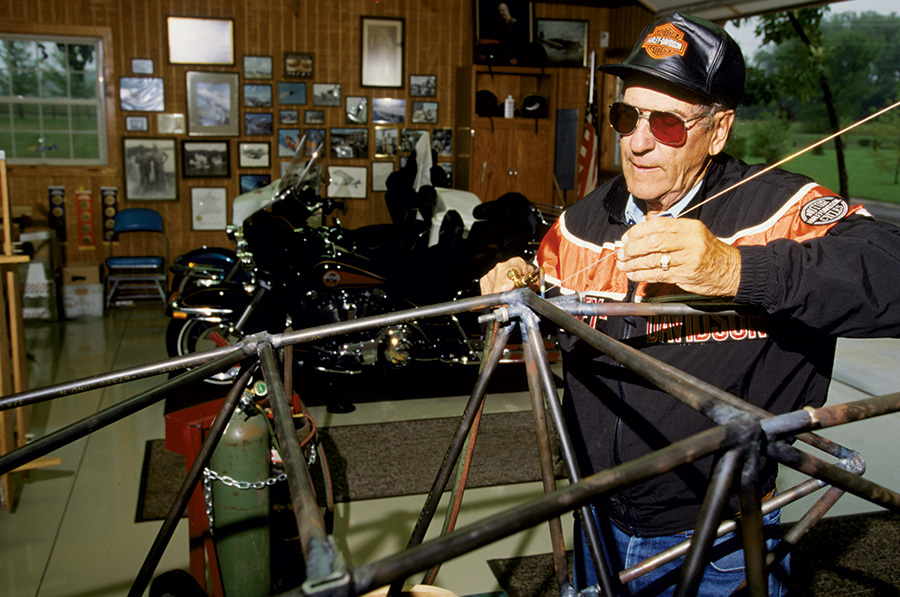
Paul loved his Harleys almost as much as he loved airplanes as evidenced in this photo with his motorcycles in the background and his Harley-Davidson apparel.
A Warbird for Your Thoughts…
Directing the daily operations of Wittman Airport is no ordinary airport management position, but Peter Moll handles it with aplomb. And liaising with EAA? That’s a natural for this former executive director of EAA Warbirds. “Of course, Paul was the first executive director of Warbirds, so I considered him my mentor,” said Moll. “Once I became airport director, Paul would take the time to pop into my office and talk history—he was such a wealth of aviation knowledge—he’d been so many places!”
Paul also made suggestions, drawing on the facilities and amenities he’d seen at other airports when traveling. “He suggested we put in a playground, like he’d seen at Peachtree-DeKalb airport in Georgia, for example. Just good ideas for keeping people engaged with the airport. I miss him,” mused Moll.
Chapters are like Churches
When it came to organization building, Paul relied on Audrey for many years, until he finally retired from the military and began running the non-profit full-time, with a salary. And even then, Audrey was still key to getting things done at EAA.
It didn’t take the Pobereznys long to figure out that beyond the fly-in convention concept, membership expansion in their new-formed association could explode on a logarithmic scale by forming local chapters of EAA, first around North America, and then around the world. EAA’s membership rapidly grew from a dozen to a hundred, to a thousand, and by the 1980s, to 100,000 and more.
The growth lent strength to Paul’s lobbying efforts, first with CAA, then FAA, and allowed for an amateur-built aircraft category to blossom. Better yet, it allowed builder-pilots to carry passengers (not-for-hire) in those aircraft, and to use them in all of the other ways that private aircraft are used. Today more than 30,000 aircraft on the FAA registry are Experimental aircraft.
“Chapters are like churches for EAA, according to Paul,” said Peggy Chabrian, a former EAA board member and president of her own non-profit, Women in Aviation, International. “Paul explained this to me when I was just beginning my organization. He sat me down and told me that the EAA chapter was a gathering place where members could both spread the word about sport aviation and homebuilding,” she explained. “In the chapter members learn the history of EAA, even as they are creating its future.”
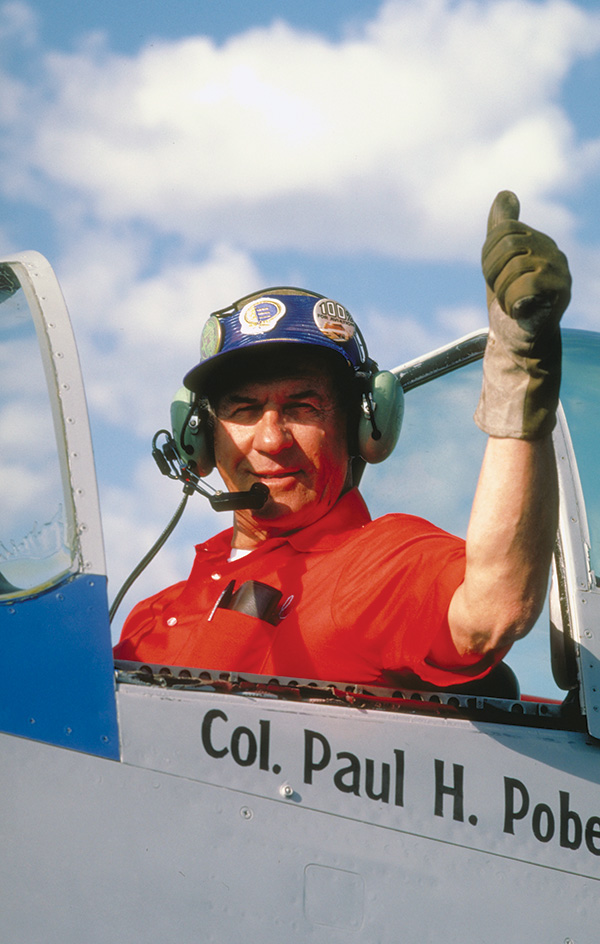
Paul flew hundreds of different types of aircraft; the P-51 Mustang was always one of his favorites.
A Millionaire to the End
Maybe it is trite, but only because Paul said it a million times, or more: “I’m a millionaire—because of EAA I have a million friends.” But he really meant it.
“There are many aspects to how my grandfather influenced me to be who I am,” contemplated Audra Hoy, Paul and Audrey’s granddaughter, and currently Chapters Manager for Women in Aviation, International. Growing up in the Poberezny family didn’t guarantee you learned to fly and went into an aviation profession, but it certainly gave one the opportunities to do so, if you ask Hoy.
“In aviation, he taught me there is just one degree of separation. If you know someone, they know someone you may know, and so on,” she explained. “It is such a tight-knit community and love for your fellow man is everything. It is a family with love for one another—and just like family, there are hiccups along the road—but the love overcomes them,” she continued. “My grandfather walked the walk, talked the talk, and he taught that to me. He treated others the way he wanted to be treated. I try to use that philosophy in my work and life everyday, whether it is returning an email, talking on the phone, or even talking with an air traffic controller in flight.”
The daughter of Bonnie Poberezny and airline pilot/aerobatic pilot Chuck Parnall, Hoy grew up on an airpark in Texas and found her way back to Oshkosh, Wisconsin, where she is, yes, married to a pilot, with one daughter, Charley.
“The WagAero Cubby I grew up flying is in my hangar now,” she smiled. And Charley? “I took my private pilot checkride when I was six months pregnant. She had her first airplane ride when she was nine days old. And she points to airplanes every time they fly over the house! She’s got an expensive hobby ahead of her, or a long aviation career,” she lamented, teasing.
These days, living near her grandparents’ house and working in the industry they helped to build is a comfort for Hoy. “It will be a different AirVenture, not seeing Pop driving all over. But his spirit will definitely be there,” she reflected.
The memories of Paul are never far away. At Audrey and Paul’s house, Paul’s logbook is lying open on a table on its last active page. “That last logged entry is the flight Pop and I took in the B-17, when I was four months pregnant with Charley,” said Hoy. “And I remember that Pop’s last flight in an airplane was a ride in the Cessna 172 with me at the controls, after I got my certificate. That was pretty awesome for me. It does feel good, thinking about that.”
He flew the old and the new that last year of his life, all while passing his knowledge, counsel, and enthusiasm for all things flying on to yet one more generation—that just about sums up Paul H. Poberezny. Good thing for us he was there.
Now it’s our job to carry on, if you ask Hoy. Clearly, Paul wanted it that way.


